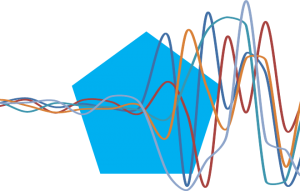 Manufacturing systems have fluctuations. Material may arrive sooner or later. Production may be fast or not. The customer may order more or less. Generally, the less fluctuations you have, the more efficiently you can produce. Toyota puts in an enormous effort to control fluctuation, but even they have fluctuation. In this post I would like to show you the three basic ways how you can decouple fluctuations: inventory, capacity, and time.
Manufacturing systems have fluctuations. Material may arrive sooner or later. Production may be fast or not. The customer may order more or less. Generally, the less fluctuations you have, the more efficiently you can produce. Toyota puts in an enormous effort to control fluctuation, but even they have fluctuation. In this post I would like to show you the three basic ways how you can decouple fluctuations: inventory, capacity, and time.
Leveling
Introduction to One-Piece Flow Leveling – Part 2 Implementation
 One successful approach to leveling is one-piece flow leveling (also known as single-piece flow or continuous flow). Last week I described the theory. This week I talk about implementation, and its combination with capacity leveling. I also look at what else there is in leveling.
One successful approach to leveling is one-piece flow leveling (also known as single-piece flow or continuous flow). Last week I described the theory. This week I talk about implementation, and its combination with capacity leveling. I also look at what else there is in leveling.
Introduction to One-Piece Flow Leveling – Part 1 Theory
 One successful approach to leveling is one-piece flow leveling, which I would like to talk about today. Another successful approach is capacity leveling. These can also be combined. (But please do yourself a favor and stay a way from a longer fixed repeating schedule EPEI leveling.) As the name already says, you should drive your lot size toward one. In addition to one-piece flow, this approach is also known as single-piece flow or continuous flow.
One successful approach to leveling is one-piece flow leveling, which I would like to talk about today. Another successful approach is capacity leveling. These can also be combined. (But please do yourself a favor and stay a way from a longer fixed repeating schedule EPEI leveling.) As the name already says, you should drive your lot size toward one. In addition to one-piece flow, this approach is also known as single-piece flow or continuous flow.
The Folly of EPEI Leveling in Practice – Part 2
 In my last post, I started to show the main reasons why EPEI leveling with a fixed repeating schedule so often fails (for details on EPEI leveling, see Theory of Every Part Every Interval (EPEI) Leveling). This post continues with more reasons and also gives some advice on how to reduce the damage or even increase its chances of success. It also has a suggestion for a test to determine if your system is ready for leveling.
In my last post, I started to show the main reasons why EPEI leveling with a fixed repeating schedule so often fails (for details on EPEI leveling, see Theory of Every Part Every Interval (EPEI) Leveling). This post continues with more reasons and also gives some advice on how to reduce the damage or even increase its chances of success. It also has a suggestion for a test to determine if your system is ready for leveling.
Again, there seems to be a lean religion that claims that putting up a leveling box will lead to salvation. Well, Lean is not a religion or magic. Lean is hard work, and you actually need to understand what you are doing. Just copying something without understanding is a good way to fail, especially with leveling.
The Folly of EPEI Leveling in Practice – Part 1
 In my last post I presented the EPEI leveling pattern (also known as EPEC, EPEx, Heijunka, fixed repeating pattern, or simply leveling). While in theory this approach looks pretty solid, in my experience it rarely works in practice. In fact, most of these types of leveling that I have seen were complete rubbish. They were a dog-and-pony-show to please management at the expense of performance and shop floor efficiency.
In my last post I presented the EPEI leveling pattern (also known as EPEC, EPEx, Heijunka, fixed repeating pattern, or simply leveling). While in theory this approach looks pretty solid, in my experience it rarely works in practice. In fact, most of these types of leveling that I have seen were complete rubbish. They were a dog-and-pony-show to please management at the expense of performance and shop floor efficiency.
Furthermore, lean manufacturing seems often to be confused with a religion. People believe that if you put up a leveling box your manufacturing system will have salvation. Well, Lean is not a religion. Lean is hard work, and you actually need to understand what you are doing. Just copying something without understanding is a good way to fail, especially with leveling.
Theory of Every Part Every Interval (EPEI) Leveling & Heijunka
 Probably among the most popular leveling approaches is Every Part Every Interval (EPEI). Often, this is the method people mean when they talk about leveling (also known as heijunka [平準化]).
Probably among the most popular leveling approaches is Every Part Every Interval (EPEI). Often, this is the method people mean when they talk about leveling (also known as heijunka [平準化]).
The theory about this type of leveling is not very difficult. Unfortunately, hard facts of reality often nullify any possible advantage of this type of leveling. In fact, most of these types of leveling that I have seen were complete rubbish. They were a dog-and-pony-show to please management at the expense of performance and shop floor efficiency. In this post I will explain to you how it is supposed to work in theory. In the next post I will explain why it rarely works in practice .
An Introduction to Capacity Leveling
 One approach to leveling (also known as heijunka [平準化], or production smoothing) is capacity leveling: Do not add more production orders into the system than what the system can handle. Try to produce the same total quantity every day. Doable for almost everybody, and one of my favorites. In fact, if you are using a pull system like kanban or CONWIP, then you are already almost there.
One approach to leveling (also known as heijunka [平準化], or production smoothing) is capacity leveling: Do not add more production orders into the system than what the system can handle. Try to produce the same total quantity every day. Doable for almost everybody, and one of my favorites. In fact, if you are using a pull system like kanban or CONWIP, then you are already almost there.
This approach is not the highest and best form of leveling, but it is doable for almost all firms. Some other approaches, notably an Every Product Every Cycle (EPEC) approach, often do more harm than good.
Why Leveling (Heijunka) is important
 Production leveling, also known as heijunka (平準化) or production smoothing, is one of the hottest topics in lean manufacturing. Successful leveling is considered one of the highest achievements in lean manufacturing. Unfortunately, if the production system is not ready for leveling, it also has lots of potential to make things worse. A lot worse! This is the first post in a longer series of post about leveling, where I will present different types of leveling and their advantages and disadvantages.
Production leveling, also known as heijunka (平準化) or production smoothing, is one of the hottest topics in lean manufacturing. Successful leveling is considered one of the highest achievements in lean manufacturing. Unfortunately, if the production system is not ready for leveling, it also has lots of potential to make things worse. A lot worse! This is the first post in a longer series of post about leveling, where I will present different types of leveling and their advantages and disadvantages.
